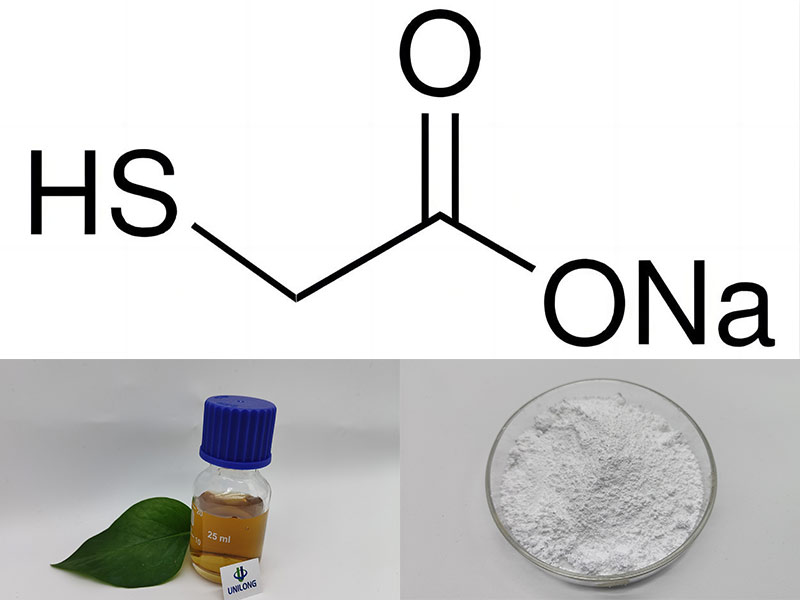โซเดียม thioglycolate is an important flotation inhibitor. It can be used as an inhibitor of copper minerals and pyrite in the flotation of copper and molybdenum ores, which has obvious inhibition effect on copper, sulfur and other minerals, and can effectively improve the grade of molybdenum concentrate. Sodium thioglycolate, as an effective inhibitor of a new type of sulfide ore, has been successfully applied in molybdenum production for many years. It has the advantages of less dosage, simple and convenient usage, better cost saving and economic benefit increase. It not only improves the quality of the product, but also has no pollution and no toxicity, and has completely replaced the highly toxic inhibitor sodium cyanide, which has played a positive role in environmental protection of the production area. This product can also be used as a hair removal agent.

ตรวจร่างกายแล้วและคุณสมบัติของสารเคมี
The sodium thioglycolate produced by the company is colorless to red (some slightly darker) transparent liquid, with a purity of 20%, 30%, 45% or more. There is also a white or white crystalline powder with a purity of 98% and excellent quality. With advanced technology and excellent process refined, has been sold to Henan, Shaanxi, Fujian, Liaoning and other places, foreign customers are mainly in Vietnam, India, Indonesia, Turkey, Brazil, Peru, the United States and other countries.
Preparation method
- Add a certain amount of water to a 1000mL beaker, add solid soda ash at room temperature, stir for 30 minutes to fully dissolve it, and then add chloroacetic acid for neutralization. The neutralization reaction of chloroacetic acid is exothermic, accompanied by the release of a large amount of carbon dioxide gas, the reaction is relatively drastic, in order to control the temperature of the neutralization reaction (the temperature is too high, the temperature is too high, the temperature is too high, the temperature is too high. Chloroacetic acid will undergo hydrolysis reaction to produce hydroxyl carboxylic acid) and prevent foam overflow during the reaction, the addition rate of chloroacetic acid is slow, and its dosage depends on the pH value of the solution; After the solution becomes clear, pour it into a three-port flask and put it into an electric heating water bath for heating reaction. When it reaches a certain temperature, add sodium thiosulfate crystal, stir and heat up to 85℃, and react at this temperature for 40 minutes to obtain salt. After the temperature continues to rise to 95℃, the strong alkali thioglycolating agent solution is added, the reaction is about 40min, the heating and stirring are stopped, the natural cooling is done, and the transparent sodium thioglycolate product can be obtained after purification.
- เพิ่ม 185g โซเดียม chloroacetate,29g บโอโซพรอบพลิว xanthoxanthate และเหมาะสมจำนวนมากของน้ำเข้าไปใน 500ml สี่ปากขวด,มีปฏิกิริยาตอน 75℃สำหรับ 2h,งั้นก็ทิ้งให้อุณหภูมิห้องและค่อยๆเพิ่ม 5%excess monoethylamine เข้าไปในสี่ปากขวดกับป่. หลังจากกากเหนือจากที่อุณหภูมิเลี้ยงต้อง 70℃และ lh เป็นยังอุ่นอยู่เลย ตอนนี้เวลาปฏิกิริยาของระบบเปลี่ยนแปลงจากความโปร่งแสงต้องเหลืองเมฆมากและในที่สุดก็กลายเป็นสีน้ำตาลเมฆมากของเหลว หยุดป่ยืน stratification ที่อัพเปอร์อีเลเยอร์เป็นสีเหลืองความโปร่งแสงของเหลวซึ่งเป็น ethylthiamine vinegar บอกว่าก้อนเนื้อออกเป็น 77.1 g งความบริสุทธิ์เป็นสิ่งที่ยิ่งใหญ่กว่า 96%ที่บโอโซพรอบพลิวแอลกอฮอล์ก้อนเศษส่วนน้อยกว่า 3.0%;ใต้เลเยอร์ก็คือด้านมืดสีแดง alkaline เสียของเหลว,บรรจุโซเดียม leucyl acetate โซเดียมคลอไรด์เป็นต้น, ซึ่งสามารถเป็นข้อถูกใช้เป็น flotation เอเจนท์ดอริทไม่ใช่
โปรแกรม
1. Application in the separation of copper and lead โซเดียม thioglycolate, as a non-toxic, small molecule inhibitor, has a good inhibition effect on chalcopyrite, and can be applied in the separation process of copper-lead mixed concentrate to achieve the separation of copper and lead. Factors such as the dedrug effect, the type and dosage of the collector, the pulp p and H value, and the amount of sodium thioglycolate during separation have important effects on the separation effect of copper and lead, but the amount of sodium thioglycolate is the most important influencing factor. When the amount is appropriate, the separation of copper and lead can be better achieved. When the amount is too large, sodium thioglycolate can inhibit both of them. Inhibition mechanism: The infrared spectral curves of sodium thioglycolate after the interaction with chalcopyrite and galena were bifurcated. After washing, the absorption valley of these characteristic groups became weak but did not disappear completely, which proved that sodium thioglycolate coexisted with physical adsorption and chemisorption on chalcopyrite and galena surface.

2. Activated sphalerite with copper sulfate in high pH slurry, lime as an inhibitor of pyrrhotite and pyrite, supplemented by sodium thioglycolate, can effectively achieve zinc-sulfur separation, industrial production test obtained grade 45.10% zinc concentrate, operation recovery of 94.39%. Sodium thioglycoacetate is a medium toxic agent, which has a good inhibition effect on pyrite and pyrrhotite, and can completely replace highly toxic cyanide to achieve cyanide-free separation process of zinc and sulfur, which not only ensures the production index of zinc concentrate grade and recovery rate, but also can meet the national environmental protection requirements. Sodium thioglycolate has little inhibitory effect on sphalerite, and has maintained good production index since the use of sodium thioglycolate.
At present, according to the needs of customers, we have opened a new production line, all using high-purity imported raw materials production, sodium thioglycolate widely used in hair removal (such as leather, human body), hair ironing and dyeing agent, solid and liquid media preparation.